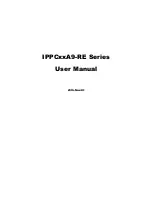
11/52
L3016
1SDH000559R0002
ABB SACE
SACE PR021/K
4.5.
Operating Mode
Depending on the setting of the dip switches and the protection unit connected, one of three operating modes may be
selected. The Signals section of each protection unit includes signal tables for each of the operating modes.
A description of the operating modes is given below.
4.5.1. Normal mode
4.5.1.1.
Normal mode with AUTOMATIC RESET disabled
To disable Automatic Reset, dip-switch no. 10 will be set to MAN (see par. 5.3), thereafter press the reset push-button
or switch PR021/K off and on.
In this operating mode each contact is associated with an event that causes the contact to close; with some contacts,
the associated event can be selected from two events by setting a dip switch (dip switch nos. 2, 3, 4).
When the protection release trips, the status of the contacts is “frozen” (any change in status of the protection is not
reflected in a change in status of the contacts). In this status, only the “protection release TRIP alarm” contact and the
contact that represents the protection that caused the trip, will be closed. For example, if protection S (selective short-
circuit) trips, the “protection release TRIP alarm” contact and the “Protection S trip (selective short-circuit)” contact will
be closed.
You can exit from the “frozen” status by resetting the signals (see par. 4.2).
4.5.1.2.
Normal mode with AUTOMATIC RESET enabled
To select the Automatic Reset function, dip-switch no. 10 will be set to AUT (see par. 5.3), thereafter press the reset
push-button or switch PR021/K off and on.
In this operating mode, the signals are the same as in Normal mode (see par. 4.5.1.1), the only difference being that, to
exit from “frozen” status following a TRIP, the trip can be directly reset on the protection unit (see user manual of the
protection unit used).
4.5.2. Latch mode
To select the Latch function, dip-switch no. 11 must be set to ON (see par. 5.3) and the reset button then be pressed or
the PR021/K unit be switched off and on
In this mode, the signals associated with each individual contact, once activated, are maintained (self-retaining of
contacts) until the signals have been reset (see par. 4.2).
N.B.
When Latch mode is activated, the automatic reset function is automatically disabled irrespective of the setting
of dip-switch no. 10.
4.5.3. User mode
To select the User function, dip-switch no. 5 must be set to B (see par. 5.3) and the reset button then be pressed or the
PR021/K unit be switched off and on
In this mode, all contacts from K51/1 to K51/8 - excluding contact K51/5 - are solely associated with the function
selected on the protection unit (refer to user manual of the protection unit used); contact K51/5 is always associated with
the “Communication problems on local bus (KO bus)” indication.
N.B.
When User mode is activated, the automatic reset and Latch mode functions are automatically disabled irrespec-
tive of the setting of dip-switches no. 10 and no. 11












































